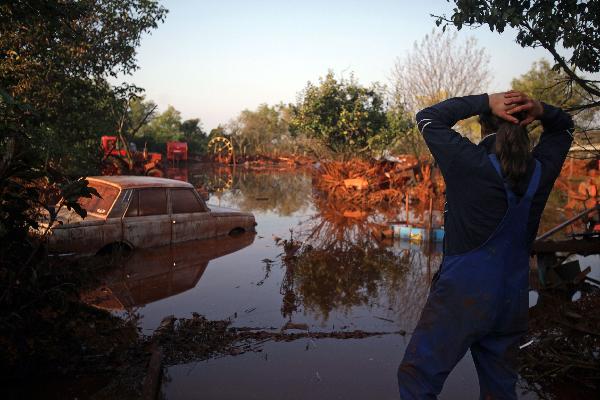Red sludge death toll rises to 7
Emergency workers found the bodies of two more victims of the toxic red sludge near the village of Devecser on Friday afternoon, bringing the death toll of the spill to seven.
Tibor Dobson, spokesman for the disaster mitigation staff reported finding the two bodies, but gave no details. Two women and one man are believed to have been missing.
An 81-year-old man hospitalized on Monday died of his injuries on Friday. Other victims were an elderly woman, a 35-year-old man drowned in his car, and two children, aged 3 and 1.
The Hungarian Aluminum Manufacturing and Trading Company, owner of the containment reservoir that released the caustic sludge which inundated three villages and wiped out all living matter in the Torna creek and Marcal river, issued a statement on Friday, arguing that it had not violated any rules. The company's measurements of the chemistry in the reservoir, CEO Zoltan Bakonyi said, yielded normal values, and a Monday morning inspection of the retaining wall found nothing of concern.
He said that seepage, reported by staff weeks ago, was normal in a facility of that size and the sludge leaks had been collected and returned to the reservoir.
State Secretary for the Environment Zoltan Illes said on Friday that while the magnesium and calcium nitrates introduced into the Raba and Marcal waterways at their confluence had sufficiently reduced the pH level of the red sludge to save the Danube ecology, most of the mud had been trapped in the Marcal, where all life was destroyed.
The sludge, Illes said, covered an area of 800 to 1,000 hectares, where the contaminated topsoil will have to be removed.
Meanwhile Jozsef Varga, CEO of uranium ore company Mecsekerc and a chemical engineer by profession, told local wire service MTI that it would take months or even years to restore the natural environment. He called it folly to expect people to be able to return to their contaminated homes within a short time, adding that the next major job would be to collect the red dust covering the soil and in the atmosphere. If inhaled it will be caustic, he warned.
Varga said that clearly something hadn't been built or managed properly. "Blaming outside circumstances is cynicism," he added.
 0
0 








Go to Forum >>0 Comments